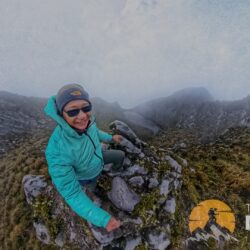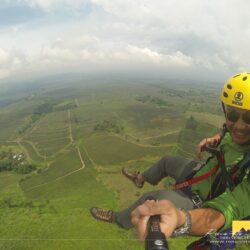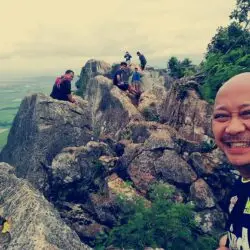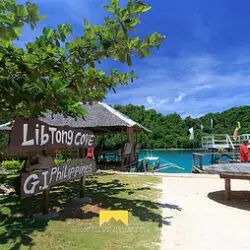Introduction – Why We Climb Hills That Aren’t Just Hills
There are trails that challenge the body, and then there are those that quietly challenge the soul. Mount Capistrano, nestled in the heart of Valencia, Bukidnon, may not be the tallest or the most intimidating peak, but for many, it offers a powerful space for reflection, presence, and awakening. For busy professionals, weighed down by deadlines and digital noise, the simple act of walking uphill becomes something more—an inward journey toward clarity.
At Trail and Frame, we believe the outdoors offers more than escape—it’s a path back to ourselves. The tagline “Trails, Frames, and the Journey Inward” reflects a deep truth: on a trail like Capistrano, with sweat on your brow and silence in your ears, you begin to hear your own voice again.
A Hill of Firsts: Russel’s Maiden Trek
Mount Capistrano marked a milestone: Russel’s first trek. In many ways, it was more than just a physical accomplishment—it was a crossing into a new kind of experience. We watched as he adjusted to the rhythm of the trail, quieted his breath, and matched his pace with the mountain’s demand. And he didn’t just manage it—he led the pack to the peak.
For those new to the world of hiking, the first trek is unforgettable. It’s a return to physicality in a world that often values intellect over embodiment. The heart races, the muscles ache, but the mind—oh, the mind begins to clear.
“Each fresh peak ascended teaches something.”
— Sir Martin Conway
More Than Just a Beginner’s Trail
Mount Capistrano is often recommended for beginners, but labeling it as “easy” would miss the deeper story. With its steep ascents and raw terrain, the trail demands attention. Yet it’s approachable, making it ideal for those training for longer climbs or returning to the mountains after time away.
More importantly, it’s a trail that offers space—for solitude, for connection, and for subtle transformation. You’re close enough to civilization to feel safe, but distant enough to feel free.
Reunions on the Ridge: Trekking Buddies Reconnect
Life has a way of scattering people across timelines and obligations. Our climb up Mount Capistrano wasn’t just about conquering elevation; it was a reunion of sorts. After a long hiatus, two of my longtime trekking companions laced up their shoes once again.
Trails have a unique ability to reforge bonds—not through drama or ceremony, but through shared effort and quiet presence.
“This Is Not My Life”: A Declaration from the Peak

Russel reached the peak ahead of us all. Fit, focused, and steady. But as he stood there, looking out over the view, he said something we weren’t expecting:
“This is not my life!”
— Russel Aguilar
No one responded immediately. We knew what that meant—or at least, we didn’t need to ask. Whether it was about burnout, dissatisfaction, or something unspoken, it was honest. And tired men, like drunk ones, often tell the truth.
The Power of Honest Realizations in Solitude
Russel’s words weren’t complaints. They were clarity. The kind that only arrives when you’ve exhausted the surface noise and touched the core of your own experience. The trail gives us that. A moment to look inward without judgment.
Grit Over Comfort: Paul’s Comeback Climb
Paul, my nephew, had every reason to skip this trek. A recovering knee injury isn’t ideal for steep climbs. And yet, he showed up—awkward gait, occasional pain, and all. He climbed not just the mountain, but past his own limitations.
True strength is often quiet. It’s not in speed, but in persistence.
The Role of Compassion in Group Treks
Russel had pulled ahead, forgetting momentarily to check on Paul. It happens. But it also became a teaching moment:
“You’re only as strong as your slowest companion.”
— Unknown
He paused, reflected, and offered a quiet apology to his cousin. It was a beautiful, humbling moment.
The Mountain Teaches: You’re Only as Strong as Your Slowest Companion
This quote became a theme for our day. In leadership, in hiking, in life—it’s not how fast you go, but who you’re willing to bring with you. Compassion is as critical as competence.
Peak vs. Process: Where True Growth Happens
Everyone loves the summit photo. But what stays with you are the muddy climbs, the tired legs, the moments you chose to keep going. The process is where growth happens, not the peak.
What the Trail Taught Us About Ego, Empathy, and Endurance
On the trail, ego gets stripped down. Nature doesn’t care about your title. It only honors presence and persistence. Empathy and endurance carry more weight than muscle.
Reflection from the Ridge: How This Trek Changed Us
By the descent, something in us had shifted. There was less conversation, more presence. This wasn’t just another hike. It was a reset.
The Inner Journey: Hiking as a Tool for Self-Awareness
Burnout often goes unspoken. Hiking gives us a framework to reconnect with ourselves in a nonverbal, intuitive way. Mount Capistrano became our mirror—and we liked who we were becoming.
Practical Tips for Professionals Considering Their First Hike
- Start small: Trails like Mount Capistrano are perfect for beginners.
- Gear wisely: Prioritize comfort and safety.
- Mind your pace: You don’t have to prove anything.
- Be present: Leave your phone and deadlines behind.
- Hike solo or with support: Both have value—choose what you need.
Final Thoughts: Hills that Heal, Trails that Teach
We came to climb a hill. We left with insights we didn’t know we needed. That’s what trails do. They don’t just take you places—they take you inward.
FAQs
1. What makes Mount Capistrano a good hike for beginners?
Mount Capistrano offers a well-defined trail, moderate difficulty, and manageable elevation—ideal for first-time hikers.
2. How long does the hike typically take?
Roughly 2–3 hours round-trip, depending on fitness and pacing.
3. Is Mount Capistrano suitable for those recovering from injury?
It can be, but always consult your doctor. Paul did it—post-knee injury—with determination and care.
4. What mindset should professionals bring to their first hike?
Curiosity over conquest. Let nature lead and be open to reflection.
5. Can hiking really help with burnout?
Yes. Hiking engages the body, clears the mind, and reconnects you with purpose and presence.
Ready to lace up your boots and head toward clarity? Let the trail show you who you are—one mindful step at a time.
















